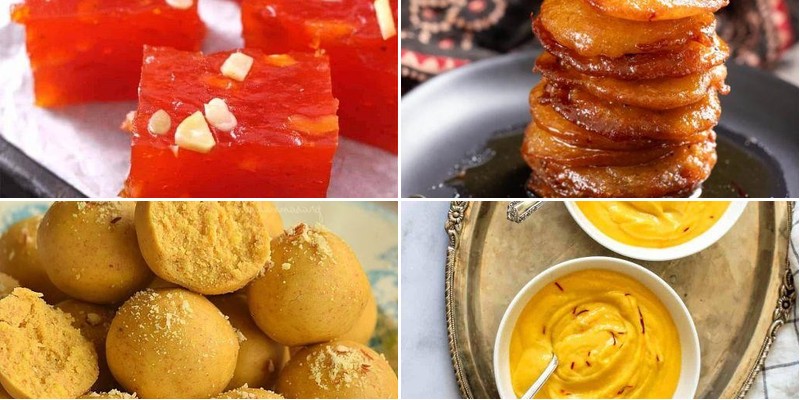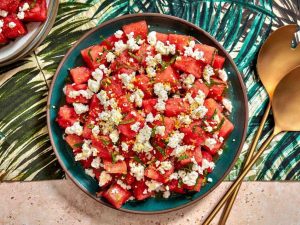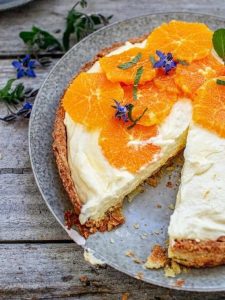Let’s be honest—sometimes you just need something sweet, and Indian desserts deliver that perfect balance of exotic flavors and comforting familiarity. Whether you’re craving creamy kheer, syrup-soaked gulab jamun, or rich barfi, we’ve gathered 31 irresistible, easy-to-make recipes that bring the magic of Indian sweets right to your kitchen. Get ready to impress your family and friends with these delightful treats!
Gulab Jamun

Glistening like precious jewels in golden syrup, gulab jamun represents the pinnacle of Indian confectionery artistry, where delicate milk-solid spheres transform into ethereal desserts through careful preparation and aromatic infusion. Velvety textures and floral notes create an unforgettable sensory experience that transcends ordinary sweets, making this traditional treat worthy of any sophisticated dessert table. Each bite offers a harmonious balance of richness and subtle sweetness that lingers delightfully on the palate.
Ingredients
– 1 cup full-fat milk powder
– ¼ cup all-purpose flour
– ½ teaspoon baking powder
– 2 tablespoons clarified butter (ghee), chilled
– ¼ cup whole milk, chilled
– 2 cups granulated sugar
– 2 cups filtered water
– 4 green cardamom pods, lightly crushed
– 1 teaspoon rose water
– 4 cups vegetable oil for deep frying
– 1 tablespoon raw pistachios, finely slivered
Instructions
1. Combine 1 cup milk powder, ¼ cup all-purpose flour, and ½ teaspoon baking powder in a medium mixing bowl, whisking thoroughly to ensure even distribution.
2. Incorporate 2 tablespoons chilled clarified butter into the dry ingredients using your fingertips, working until the mixture resembles coarse sand.
3. Gradually add ¼ cup chilled whole milk while gently kneading, stopping as soon as the dough comes together without overworking.
4. Cover the dough with a damp kitchen towel and rest at room temperature for exactly 15 minutes to hydrate properly.
5. Meanwhile, create the syrup by combining 2 cups granulated sugar with 2 cups filtered water in a heavy-bottomed saucepan.
6. Add 4 lightly crushed green cardamom pods to the syrup mixture and bring to a boil over medium-high heat, stirring occasionally.
7. Reduce heat to low and simmer the syrup for exactly 8 minutes until it reaches a thin, honey-like consistency.
8. Remove syrup from heat and stir in 1 teaspoon rose water, then transfer to a wide, shallow bowl to cool completely.
9. Divide the rested dough into 16 equal portions, rolling each between your palms to form smooth, crack-free spheres.
10. Heat 4 cups vegetable oil in a deep, heavy-bottomed pot to precisely 300°F, using a candy thermometer for accuracy.
11. Carefully slide 4-5 dough balls into the hot oil and fry for 4-5 minutes, gently rotating with a slotted spoon for even browning.
12. Increase oil temperature to 325°F and continue frying for another 2-3 minutes until the jamuns achieve a deep golden-brown hue.
13. Immediately transfer the fried jamuns to the cooled syrup, ensuring they’re fully submerged, and soak for at least 2 hours.
14. Garnish the soaked gulab jamuns with 1 tablespoon finely slivered raw pistachios before serving.
Velvety soft interiors give way to delicate, porous textures that have absorbed the floral syrup perfectly, creating a dessert that melts luxuriously in the mouth. The subtle cardamom undertones and rose essence elevate these golden spheres beyond mere sweetness into aromatic sophistication. For an elegant presentation, serve warm with a scoop of saffron-infused ice cream or arrange on a platter drizzled with reduced syrup and edible gold leaf for special occasions.
Rasgulla
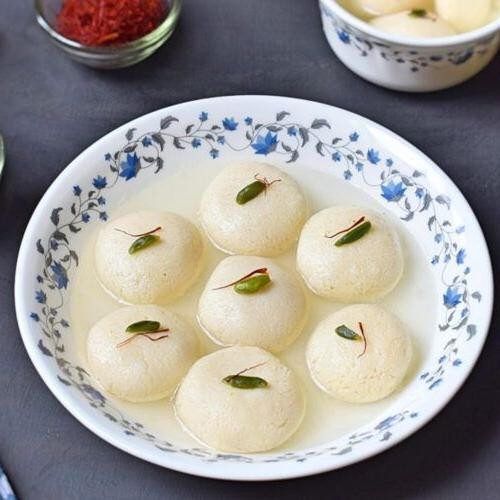
Wrapped in delicate, cloud-like spheres that float serenely in fragrant syrup, rasgulla represents the pinnacle of Indian confectionery artistry—a dessert that transforms simple ingredients into ethereal sweetness through precise technique and patience. These spongy cheese dumplings, originating from Bengal but beloved worldwide, offer a sublime textural experience where each bite releases a burst of cardamom-infused syrup against the gentle resistance of fresh paneer. Mastering this classic requires attention to temperature control and kneading technique, but rewards with dessert perfection that feels both luxurious and comforting.
Ingredients
– 1 gallon whole milk, preferably organic
– ¼ cup freshly squeezed lemon juice, strained
– 2 cups granulated sugar
– 4 cups filtered water
– 4 whole green cardamom pods, lightly crushed
– 1 teaspoon rose water
Instructions
1. Pour the whole milk into a heavy-bottomed stainless steel pot and heat over medium heat until it reaches 180°F, stirring occasionally to prevent scorching.
2. Remove the milk from heat and gradually add the strained lemon juice while stirring gently until curds separate from whey completely.
3. Line a fine-mesh strainer with cheesecloth and carefully pour the curdled milk mixture through it to separate the paneer.
4. Rinse the paneer under cold running water for 2 minutes to remove any residual lemon flavor.
5. Gather the cheesecloth corners and twist to form a tight bundle, then hang the paneer for 30 minutes to drain excess moisture.
6. Unwrap the paneer and transfer to a clean surface, then knead vigorously for 10-12 minutes until it becomes smooth, pliable, and slightly glossy.
7. Divide the kneaded paneer into 20 equal portions and roll each into perfectly smooth, crack-free balls about 1 inch in diameter.
8. Combine granulated sugar, filtered water, and crushed cardamom pods in a wide, heavy-bottomed pot and bring to a rolling boil over high heat.
9. Gently drop the paneer balls into the boiling syrup, ensuring they have ample space to expand without touching.
10. Cover the pot with a tight-fitting lid and cook over medium-high heat for exactly 15 minutes, resisting the urge to open the lid during cooking.
11. Remove the lid and check that the rasgullas have doubled in size and appear porous and spongy when pressed gently.
12. Drizzle the rose water over the syrup and gently stir to incorporate without breaking the delicate dumplings.
13. Remove the pot from heat and let the rasgullas cool completely in the syrup for at least 2 hours to allow proper absorption.
Heavenly in their delicate balance, these rasgullas offer a sublime textural contrast—firm yet yielding exteriors giving way to syrup-saturated, melt-in-your-mouth interiors. The cardamom’s warm spice and rose water’s floral notes create an aromatic complexity that elevates this beyond simple sweetness. For an elegant presentation, serve chilled in crystal coupes garnished with edible rose petals, or create a contemporary dessert by pairing with saffron-infused whipped cream and pistachio crumble.
Kheer
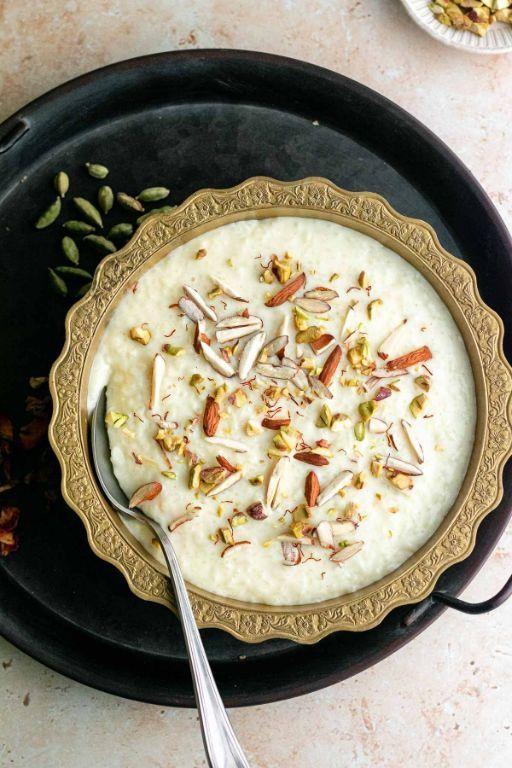
Glistening with the subtle sophistication of ancient traditions, kheer stands as India’s most cherished rice pudding—a dessert where fragrant basmati rice simmers slowly in cardamom-kissed milk until achieving sublime creaminess. This timeless delicacy transforms humble ingredients into an elegant finale, its delicate floral notes and textural harmony making it equally suited for intimate dinners or celebratory feasts. Each spoonful carries the warmth of generations, a dessert that comforts while astonishing with its refined simplicity.
Ingredients
- 1 cup premium basmati rice, rinsed until water runs clear
- 4 cups whole milk, preferably organic
- 1 cup heavy cream
- 3/4 cup granulated sugar
- 1/4 cup golden raisins
- 2 tablespoons ghee (clarified butter)
- 1 teaspoon freshly ground green cardamom pods
- 1/4 cup raw pistachios, finely slivered
- 1/4 cup blanched almonds, thinly sliced
- Large pinch of saffron threads, steeped in 2 tablespoons warm milk
Instructions
- Place rinsed basmati rice in a medium heavy-bottomed saucepan and cover with 2 cups cold water.
- Bring rice and water to a vigorous boil over high heat, then immediately reduce to a gentle simmer.
- Cook rice uncovered for exactly 8 minutes, until grains are tender but still maintain structural integrity.
- Drain any remaining water completely using a fine-mesh strainer.
- Return the empty saucepan to medium heat and add ghee, swirling to coat the bottom evenly.
- Toast the drained rice in ghee for 2 minutes, stirring constantly until grains appear slightly translucent.
- Pour in whole milk and heavy cream simultaneously, using a wooden spoon to scrape any rice grains from the bottom.
- Bring the mixture to 180°F, indicated by small bubbles forming around the edges of the saucepan.
- Reduce heat to the lowest setting and maintain a bare simmer, stirring every 4 minutes to prevent scorching.
- Cook for 35-40 minutes until the rice has broken down and the mixture has reduced by one-third.
- Add granulated sugar and stir continuously for 2 minutes until completely dissolved.
- Incorporate ground cardamom and saffron-infused milk, stirring to distribute the golden hue evenly.
- Fold in golden raisins and continue cooking for 5 additional minutes.
- Remove from heat and allow to cool to room temperature, about 45 minutes.
- Transfer to serving bowls and garnish generously with slivered pistachios and sliced almonds.
Just beyond its creamy surface lies a dessert of remarkable complexity—the rice grains maintain their individual identity while contributing to the overall velvet texture. Each spoonful delivers the floral whisper of cardamom followed by the luxurious crunch of nuts and the occasional burst of plump raisins. For an elegant presentation, serve chilled in martini glasses with a dusting of edible rose petals, or warm in handmade ceramic bowls for comforting winter evenings.
Jalebi

Fragrant with cardamom and glistening with syrup, these golden jalebis offer a sublime balance of crisp texture and floral sweetness that transforms any afternoon into a celebration. Each intricate swirl captures the essence of traditional Indian confectionery while inviting modern palates to discover its delicate complexity. This version elevates the classic with precise techniques that ensure consistently perfect results.
Ingredients
- 1 cup all-purpose flour, sifted
- 2 tablespoons chickpea flour
- 1 ¼ cups granulated sugar
- 1 cup water, divided
- ½ teaspoon saffron threads, crushed
- 4 green cardamom pods, seeds removed and finely ground
- ¼ teaspoon active dry yeast
- 2 tablespoons plain yogurt
- 4 cups vegetable oil for frying
- 1 teaspoon rose water
- 1 tablespoon raw pistachios, finely slivered
Instructions
- Combine sifted all-purpose flour, chickpea flour, active dry yeast, and yogurt with ¾ cup lukewarm water in a medium bowl.
- Whisk the mixture vigorously for 2 minutes until completely smooth and free of lumps.
- Cover the bowl with plastic wrap and let ferment in a warm place for 8 hours until bubbles form across the surface.
- Create the sugar syrup by combining granulated sugar, remaining ¼ cup water, crushed saffron threads, and ground cardamom in a saucepan.
- Heat the syrup mixture over medium heat, stirring constantly until sugar dissolves completely.
- Simmer the syrup at 220°F for 5 minutes until it reaches a one-string consistency when tested between thumb and forefinger.
- Remove syrup from heat and stir in rose water, then maintain warmth over lowest heat setting.
- Heat vegetable oil in a deep kadai or heavy-bottomed pot to 350°F, verified with a deep-fry thermometer.
- Transfer fermented batter to a piping bag fitted with a medium round tip or a squeeze bottle with narrow opening.
- Pipe concentric spiral shapes directly into the hot oil, working quickly to form 3-inch diameter circles.
- Fry jalebis for 90 seconds until the bottom develops a pale golden color and crisp texture.
- Carefully flip each jalebi using a spider strainer and fry for another 90 seconds until uniformly golden and crisp.
- Immediately transfer fried jalebis to the warm sugar syrup, submerging completely for 45 seconds to absorb maximum sweetness.
- Remove syrup-soaked jalebis to a wire rack set over a baking sheet to drain excess syrup for 2 minutes.
- Garnish warm jalebis with finely slivered raw pistachios just before serving.
While the exterior maintains an audible crispness that gives way to syrup-soaked tenderness, the floral notes of rose water and cardamom create an aromatic complexity that lingers beautifully. For an elegant presentation, serve these golden spirals alongside a scoop of saffron ice cream or arrange them over thickened Greek yogurt drizzled with honey. The contrast between the crackling shell and the saturated interior makes each bite a study in textural harmony.
Besan Ladoo
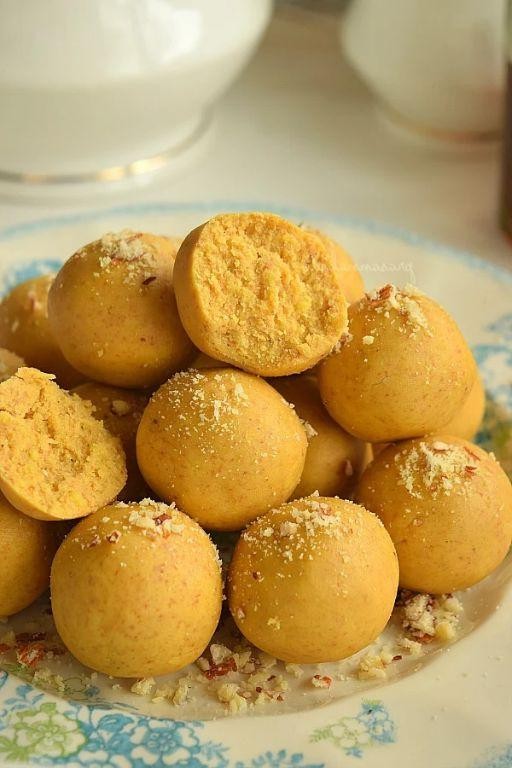
Warm, golden spheres of besan ladoo offer a sublime introduction to Indian confectionery, where roasted chickpea flour meets aromatic spices in a delicate dance of textures. These traditional sweets balance earthy depth with floral sweetness, creating bite-sized treasures that melt luxuriously on the tongue. Crafting them requires precision and patience, but rewards with confections worthy of celebration.
Ingredients
– 2 cups fine chickpea flour (besan)
– ¾ cup clarified butter (ghee)
– 1 cup superfine cane sugar
– ¼ teaspoon freshly ground green cardamom
– 2 tablespoons raw pistachios, finely slivered
– 1 tablespoon golden raisins
– 1 pinch saffron threads, steeped in 1 tablespoon warm whole milk
Instructions
1. Place a heavy-bottomed kadhai or skillet over medium-low heat and add the clarified butter.
2. Once the ghee melts completely and reaches 200°F, gradually incorporate the chickpea flour while continuously stirring with a wooden spatula.
3. Roast the flour-ghee mixture for 18-22 minutes, adjusting heat to maintain a steady golden hue without browning.
4. Test for doneness by pressing a small amount between your fingers—it should release aromatic oils and feel completely smooth without grittiness.
5. Transfer the roasted mixture to a wide marble slab or baking sheet and cool to precisely 110°F, about 12-15 minutes.
6. Combine the superfine cane sugar and freshly ground green cardamom in a separate bowl.
7. Gradually fold the sugar mixture into the cooled besan using a cutting motion to maintain airiness.
8. Drizzle the saffron-infused milk evenly across the mixture while gently tossing with your fingertips.
9. Incorporate the finely slivered pistachios and golden raisins, distributing them uniformly.
10. Take approximately 2 tablespoons of the mixture and compress firmly between your palms to form smooth, crack-free spheres.
11. Arrange the formed ladoos on parchment-lined trays and rest at room temperature for 2 hours to set completely.
Just crafted, these besan ladoos reveal a sophisticated granular texture that yields to gentle pressure, releasing waves of toasted nuttiness and floral cardamom. The saffron’s subtle earthiness elevates the sweetness, while pistachios provide satisfying crunch. For an elegant presentation, nestle them in individual gold foil cups and serve alongside masala chai, allowing the spices to harmonize beautifully.
Barfi

Delicately textured and jewel-like in appearance, barfi is an exquisite Indian confection that transforms simple pantry staples into an elegant dessert worthy of any celebration. Distinguished by its fudge-like consistency and aromatic complexity, this sweet treat offers a sophisticated balance of creamy richness and subtle floral notes. During festive seasons or as an impressive finale to dinner parties, barfi provides a memorable culinary experience that transcends cultural boundaries.
Ingredients
– 4 cups full-fat milk powder
– 1 ½ cups granulated sugar
– 1 cup heavy whipping cream
– ½ cup clarified butter (ghee)
– ¼ cup sliced pistachios
– ¼ cup silvered almonds
– 1 teaspoon cardamom powder, freshly ground
– ½ teaspoon rose water
– Pinch of saffron threads
Instructions
1. Lightly grease an 8×8 inch square baking pan with 1 tablespoon of clarified butter, ensuring complete coverage of the surface.
2. Combine milk powder, sugar, heavy cream, and remaining clarified butter in a heavy-bottomed saucepan over medium heat.
3. Stir continuously with a wooden spatula for 8-10 minutes until the mixture thickens and pulls away from the sides of the pan.
4. Add freshly ground cardamom powder and rose water, mixing thoroughly to distribute the aromatics evenly.
5. Continue cooking for another 5-7 minutes until the mixture forms a cohesive mass that holds its shape when pressed.
6. Transfer the hot mixture to the prepared baking pan, spreading it evenly with an offset spatula to create a smooth surface.
7. Immediately press sliced pistachios, silvered almonds, and saffron threads into the surface in an artistic pattern.
8. Allow the barfi to cool completely at room temperature for 2 hours until firm to the touch.
9. Refrigerate the pan for 1 additional hour to achieve perfect slicing consistency.
10. Cut the chilled barfi into 1-inch diamond shapes using a sharp knife wiped clean between cuts.
When properly prepared, barfi offers a melt-in-the-mouth texture that contrasts beautifully with the satisfying crunch of nut embellishments. The sophisticated interplay of creamy dairy notes, floral undertones, and warm spice creates a dessert that delights both the palate and the senses. Consider serving these jewel-like pieces alongside masala chai or as an unexpected element in a modern dessert charcuterie board for contemporary entertaining.
Rava Kesari

Vibrant with the golden hue of saffron and fragrant with cardamom, Rava Kesari is an exquisite Indian dessert that transforms humble semolina into an aromatic, jewel-toned confection. This traditional sweet, often served during celebrations, balances the nutty richness of clarified butter with the delicate floral notes of saffron in perfect harmony. Its luxurious texture and sophisticated flavor profile make it an impressive yet accessible finale to any meal.
Ingredients
- 1 cup fine semolina
- ¾ cup granulated sugar
- ½ cup clarified butter (ghee)
- 2½ cups filtered water
- ¼ teaspoon saffron threads
- ½ teaspoon cardamom seeds, freshly ground
- 2 tablespoons golden raisins
- 2 tablespoons raw cashew pieces
- Pinch of edible camphor (optional)
Instructions
- Place a heavy-bottomed saucepan over medium heat and add the clarified butter, allowing it to melt completely until it reaches 250°F.
- Add the raw cashew pieces to the heated clarified butter and toast for 90 seconds, stirring continuously until they develop a light golden-brown color.
- Introduce the golden raisins to the saucepan and sauté for 45 seconds until they plump noticeably and become glossy.
- Reduce the heat to medium-low and carefully add the fine semolina to the pan, spreading it evenly across the surface.
- Roast the semolina mixture for 8-10 minutes, stirring constantly with a wooden spatula until it releases a nutty aroma and turns pale golden.
- While the semolina roasts, combine the filtered water and saffron threads in a separate saucepan and bring to a rolling boil at 212°F.
- Slowly pour the boiling saffron-infused water into the roasted semolina mixture, stirring vigorously to prevent lump formation.
- Continue cooking the mixture over medium heat for 5-7 minutes, stirring constantly until the semolina absorbs all the liquid and thickens to a paste-like consistency.
- Add the granulated sugar to the thickened semolina mixture and stir continuously for 4-5 minutes until the sugar completely dissolves and the mixture becomes glossy.
- Sprinkle the freshly ground cardamom seeds and optional edible camphor over the kesari, folding them gently into the mixture until evenly distributed.
- Transfer the prepared Rava Kesari to a greased serving dish and smooth the surface with a buttered spatula.
- Allow the dessert to rest at room temperature for 15 minutes before serving to let the flavors meld and the texture set properly.
An aromatic masterpiece, Rava Kesari offers a delightful contrast between its creamy, pudding-like interior and the satisfying crunch of toasted cashews. The sophisticated interplay of saffron’s earthy sweetness and cardamom’s citrus-tinged warmth creates a complex flavor profile that lingers pleasantly on the palate. For an elegant presentation, serve individual portions in miniature copper bowls garnished with edible gold leaf and fresh rose petals.
Kulfi
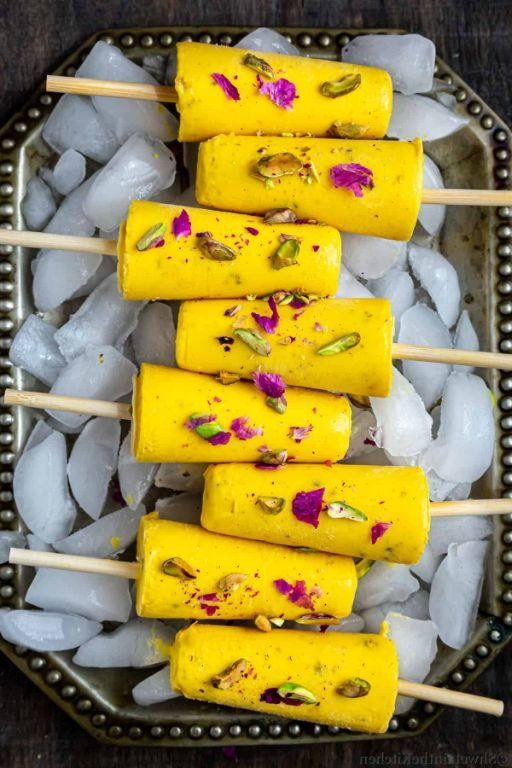
Beyond the realm of ordinary frozen desserts lies kulfi, an Indian ice cream whose dense, aromatic richness transports the palate to spice markets and royal kitchens. Crafted through patient reduction rather than churning, this frozen confection develops an unparalleled creaminess that clings luxuriously to the spoon. Each velvety bite carries the haunting fragrance of cardamom and the subtle complexity of slowly caramelized dairy.
Ingredients
– 4 cups whole milk
– 1 cup heavy cream
– 3/4 cup granulated sugar
– 1/4 cup crushed pistachios
– 2 tablespoons chopped almonds
– 1 teaspoon ground cardamom
– 1/4 teaspoon saffron threads
– 1 tablespoon rose water
Instructions
1. Combine 4 cups whole milk and 1 cup heavy cream in a heavy-bottomed saucepan over medium heat.
2. Bring the dairy mixture to 180°F, stirring continuously with a wooden spoon to prevent scorching.
3. Reduce heat to maintain a gentle simmer and cook for 45 minutes, stirring every 5 minutes to develop a pale golden color.
4. Add 3/4 cup granulated sugar and continue simmering for 15 minutes until the mixture thickens to coat the back of a spoon.
5. Stir in 1 teaspoon ground cardamom and 1/4 teaspoon saffron threads until fully incorporated.
6. Remove from heat and stir in 1 tablespoon rose water for floral complexity.
7. Cool the mixture to room temperature, then cover and refrigerate for 4 hours until thoroughly chilled.
8. Pour the chilled mixture into kulfi molds or 6-ounce ramekins, filling each three-quarters full.
9. Sprinkle 1/4 cup crushed pistachios and 2 tablespoons chopped almonds evenly over each portion.
10. Freeze for 8 hours or overnight until completely solid.
For optimal texture, allow the kulfi to temper at room temperature for 5 minutes before serving. The dense, almost chewy consistency melts slowly on the tongue, revealing layers of caramelized milk, floral rose, and warming spices. Serve garnished with edible rose petals for an elegant presentation, or pair with fresh mango slices during summer months for contrasting textures and temperatures.
Halwa
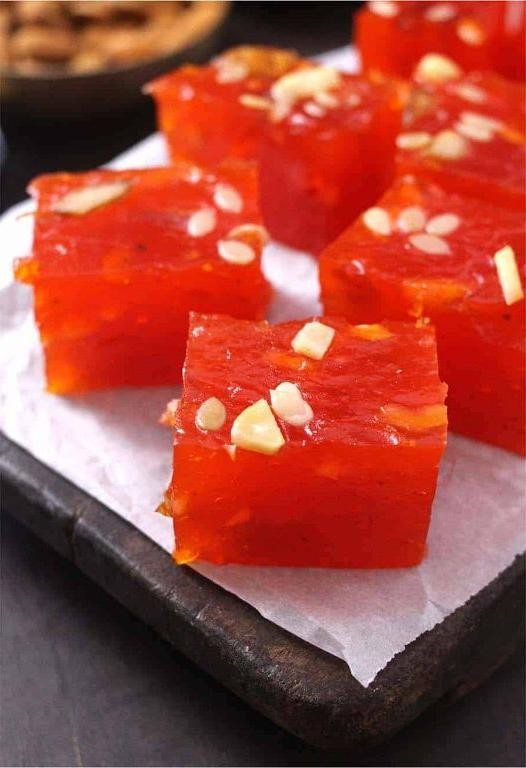
Jewel-toned and fragrant, halwa represents the pinnacle of comfort desserts across Middle Eastern and South Asian traditions, where its velvety texture and aromatic spices transform simple ingredients into something truly transcendent. This particular version balances earthy semolina with the delicate sweetness of raw cane sugar, creating a dessert that feels both rustic and refined. Each spoonful offers a journey through warm spice notes and comforting textures that linger beautifully on the palate.
Ingredients
– 1 cup fine semolina flour
– ¾ cup raw cane sugar
– 4 tablespoons clarified butter (ghee)
– 2 cups whole milk, warmed to 110°F
– ½ teaspoon ground cardamom
– ¼ cup golden raisins
– 2 tablespoons sliced raw almonds
– 1 teaspoon rose water
Instructions
1. Heat the clarified butter in a heavy-bottomed saucepan over medium heat until it shimmers and releases a nutty aroma.
2. Add the fine semolina flour and toast for 8-10 minutes, stirring constantly with a wooden spoon until it turns golden brown and fragrant.
3. Pour in the warmed whole milk gradually while continuously whisking to prevent lumps from forming.
4. Incorporate the raw cane sugar and ground cardamom, stirring until the sugar completely dissolves into the mixture.
5. Reduce heat to low and cook for 12-15 minutes, stirring frequently, until the halwa pulls away from the sides of the pan and thickens to a pudding-like consistency.
6. Fold in the golden raisins and sliced raw almonds, distributing them evenly throughout the warm mixture.
7. Remove from heat and stir in the rose water until just incorporated, being careful not to overmix.
8. Transfer immediately to serving bowls and allow to rest for 5 minutes before serving to let the flavors meld.
Creating an exceptionally smooth texture relies on constant stirring during the toasting phase, while gradually adding warmed milk prevents the semolina from clumping. The final addition of rose water after removing from heat preserves its delicate floral notes. Comforting yet sophisticated, this halwa achieves a perfect balance between the granular texture of toasted semolina and the creamy richness of reduced milk. The floral undertones from rose water elevate the warm cardamom notes, making it particularly lovely when served warm with a dusting of crushed pistachios or alongside strong black tea.
Mango Shrikhand
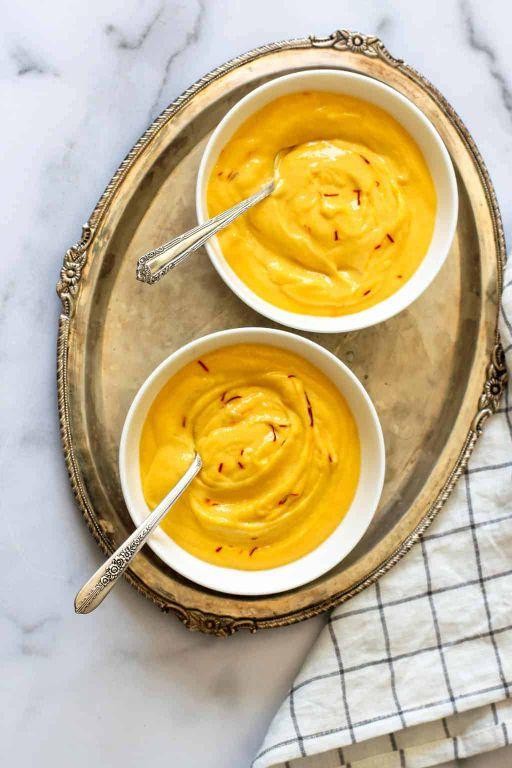
Unveiling the sublime fusion of Indian tradition and tropical elegance, this mango shrikhand transforms humble yogurt into an ethereal dessert that captivates both palate and presentation. Using the golden sweetness of ripe Alphonso mangoes, this chilled delicacy offers a refreshing sophistication perfect for warm evenings or celebratory gatherings. Its velvety texture and aromatic complexity make it an unforgettable conclusion to any meal.
Ingredients
– 32 ounces full-fat Greek yogurt
– 2 ripe Alphonso mangoes
– ½ cup superfine sugar
– ½ teaspoon freshly ground green cardamom
– 2 tablespoons raw pistachios, finely chopped
– 1 teaspoon edible rose petals
– 1 pinch saffron threads
Instructions
1. Line a fine-mesh sieve with double-layered cheesecloth and place it over a medium bowl.
2. Transfer 32 ounces of full-fat Greek yogurt to the cheesecloth-lined sieve, gathering the edges to form a pouch.
3. Refrigerate the yogurt pouch for 8 hours to drain excess whey, resulting in a thick, spoonable consistency.
4. Peel 2 ripe Alphonso mangoes and carefully remove the flesh from the central pit.
5. Purée the mango flesh in a high-speed blender until completely smooth, about 2 minutes.
6. Combine the strained yogurt, mango purée, and ½ cup superfine sugar in a large mixing bowl.
7. Whisk vigorously for 3 minutes until the sugar fully dissolves and the mixture becomes uniformly creamy.
8. Crush ½ teaspoon freshly ground green cardamom using a mortar and pestle to release its aromatic oils.
9. Gently fold the crushed cardamom into the yogurt mixture using a spatula.
10. Soak 1 pinch of saffron threads in 1 tablespoon of warm water for 5 minutes until the water turns golden.
11. Drizzle the saffron infusion over the shrikhand and swirl gently with a knife to create marbled patterns.
12. Transfer the shrikhand to individual serving bowls and chill for 2 hours to allow flavors to meld.
13. Garnish each portion with 2 tablespoons of finely chopped raw pistachios and 1 teaspoon of edible rose petals before serving.
Velvety and luxuriously smooth, this shrikhand delivers a harmonious balance between the tangy yogurt base and the tropical sweetness of mango. The floral notes of cardamom and saffron elevate each spoonful, while the crunchy pistachios provide delightful textural contrast. Serve it in chilled martini glasses for an elegant presentation, or layer it with granola for a sophisticated breakfast parfait that transforms morning routines into sensory experiences.
Coconut Burfi

Meticulously crafted from just a handful of premium ingredients, coconut burfi offers a sublime introduction to Indian confectionery—a diamond-cut sweet that transforms humble coconut into an elegant, melt-in-your-mouth delicacy with nuanced caramel notes and tropical fragrance. This traditional fudge-like treat requires precise technique but rewards with its sophisticated simplicity and luxurious texture.
Ingredients
– 4 cups freshly grated coconut
– 2 cups granulated sugar
– 1 cup whole milk
– ½ cup clarified butter (ghee)
– ½ teaspoon ground cardamom
– ¼ cup raw pistachios, finely chopped
– 1 tablespoon rose water
Instructions
1. Line an 8×8-inch baking pan with parchment paper, ensuring the paper extends slightly over the edges for easy removal.
2. Combine the freshly grated coconut, granulated sugar, and whole milk in a heavy-bottomed saucepan over medium heat.
3. Stir continuously with a wooden spoon for 12-15 minutes until the mixture thickens and pulls away from the sides of the pan. Tip: A heavy-bottomed pan prevents scorching and ensures even heat distribution.
4. Add the clarified butter and continue stirring for another 8-10 minutes until the mixture forms a cohesive mass and develops a pale golden hue.
5. Stir in the ground cardamom and rose water, mixing thoroughly to distribute the flavors evenly.
6. Immediately transfer the mixture to the prepared pan, spreading it evenly with an offset spatula to create a smooth, level surface. Tip: Work quickly while the mixture is still warm and pliable for perfect shaping.
7. Sprinkle the finely chopped raw pistachios evenly across the surface, gently pressing them into the mixture with the back of a spoon.
8. Allow the burfi to cool completely at room temperature for 2 hours until firm to the touch. Tip: For clean cuts, chill the set burfi in the refrigerator for 30 minutes before slicing.
9. Using a sharp knife, cut the cooled burfi into 1-inch diamond shapes or squares.
The finished burfi possesses a firm yet yielding texture that dissolves delicately on the tongue, releasing waves of tropical coconut and aromatic cardamom. The subtle rosewater undertones and crunchy pistachio garnish create a sophisticated flavor profile that pairs beautifully with masala chai or as an elegant finale to a multi-course meal. For a contemporary presentation, serve individual pieces atop edible gold leaf with a dusting of edible silver leaf for added opulence.
Malpua
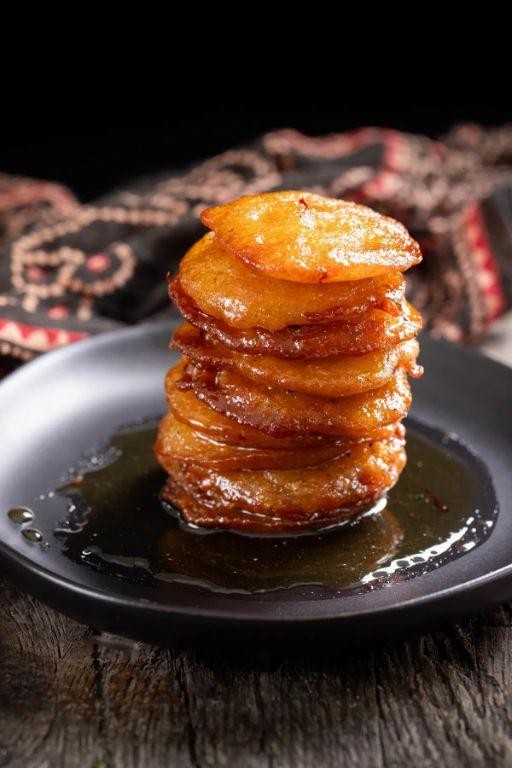
Tantalizingly fragrant and golden-crisp, malpua represents the pinnacle of Indian dessert artistry, where delicate pancake-like discs meet aromatic sugar syrup in a symphony of textures. This centuries-old sweet treat transforms simple pantry staples into an ethereal confection that balances crisp edges with tender, porous centers. Traditionally savored during festivals, these golden discs offer a captivating introduction to the nuanced world of Indian mithai.
Ingredients
– 1 cup all-purpose flour, sifted
– ¼ cup semolina flour
– 1 cup whole milk, at room temperature
– 2 pasture-raised eggs, lightly beaten
– 1 teaspoon fennel seeds, lightly crushed
– ½ teaspoon green cardamom powder
– ¼ teaspoon saffron threads, steeped in 1 tablespoon warm milk
– ½ cup granulated sugar
– ½ cup water
– 1 tablespoon rose water
– 1 cup clarified butter (ghee) for frying
– 2 tablespoons chopped pistachios for garnish
Instructions
1. Combine sifted all-purpose flour and semolina flour in a large mixing bowl.
2. Gradually pour in room temperature whole milk while whisking continuously to prevent lumps.
3. Incorporate lightly beaten pasture-raised eggs into the batter until fully integrated.
4. Stir in lightly crushed fennel seeds, green cardamom powder, and saffron-infused milk.
5. Cover the bowl with plastic wrap and let the batter rest at room temperature for 30 minutes to allow hydration.
6. Meanwhile, combine granulated sugar and water in a saucepan over medium heat.
7. Cook the syrup until it reaches 220°F on a candy thermometer, about 5-7 minutes.
8. Remove the syrup from heat and stir in rose water, then set aside to cool slightly.
9. Heat clarified butter in a heavy-bottomed skillet to 350°F, verified with a deep-fry thermometer.
10. Pour ¼ cup of batter into the hot ghee, maintaining space between each malpua.
11. Fry for 2-3 minutes until the edges appear golden brown and lacy.
12. Carefully flip each malpua using a slotted spoon and fry for another 2 minutes until uniformly golden.
13. Transfer the fried malpua directly into the warm sugar syrup.
14. Soak each malpua in syrup for exactly 45 seconds to achieve optimal saturation without becoming soggy.
15. Remove from syrup and arrange on a wire rack to drain excess liquid.
16. Garnish immediately with chopped pistachios while the syrup remains tacky.
Golden and glistening, these malpua offer a captivating contrast of crisp exteriors against syrup-infused, cake-like interiors that practically melt on the tongue. The aromatic blend of cardamom and rose water creates an elegant floral bouquet, while the fennel seeds provide subtle licorice notes that dance across the palate. For a contemporary twist, serve warm with a quenelle of saffron ice cream or alongside fresh mango slices to highlight the tropical undertones.
Phirni

Elegant yet comforting, phirni represents the sophisticated side of Indian desserts—a delicately perfumed rice pudding that transforms simple ingredients into something truly extraordinary. This chilled delicacy, traditionally served in earthenware pots, offers a sublime texture and aromatic complexity that lingers beautifully on the palate.
Ingredients
– ½ cup basmati rice, soaked overnight
– 4 cups whole milk
– ½ cup granulated sugar
– ½ teaspoon cardamom seeds, freshly ground
– 2 tablespoons raw pistachios, finely slivered
– 1 tablespoon edible rose petals
– 1 teaspoon kewra water
Instructions
1. Drain the soaked basmati rice thoroughly and transfer to a high-speed blender.
2. Pulse the rice for 15 seconds until it reaches a coarse, sand-like texture, being careful not to over-process into flour.
3. Pour the whole milk into a heavy-bottomed saucepan and bring to a gentle simmer over medium heat, stirring constantly to prevent scorching.
4. Add the ground rice to the simmering milk in a thin stream while continuously whisking to prevent lumps from forming.
5. Reduce heat to low and cook the mixture for 25 minutes, stirring every 2 minutes with a wooden spoon to ensure even cooking and prevent sticking.
6. Stir in the granulated sugar and continue cooking for 8 minutes until the sugar completely dissolves and the mixture thickens to a creamy consistency.
7. Add the freshly ground cardamom seeds and kewra water, stirring gently to distribute the aromatic flavors evenly throughout the pudding.
8. Remove the saucepan from heat and immediately transfer the phirni to individual serving bowls or traditional earthenware pots.
9. Allow the phirni to cool to room temperature for 45 minutes before covering with plastic wrap pressed directly against the surface to prevent skin formation.
10. Refrigerate the phirni for at least 4 hours, or preferably overnight, to allow the flavors to meld and the texture to set properly.
11. Garnish each serving with finely slivered raw pistachios and delicate edible rose petals just before serving.
Remarkably silken in texture, this chilled phirni offers a luxurious mouthfeel that contrasts beautifully with the subtle crunch of pistachios. The floral notes from rose and kewra water create an aromatic symphony that elevates this traditional dessert to contemporary elegance. For a stunning presentation, serve in clear glass vessels to showcase the creamy white canvas adorned with vibrant green and pink garnishes.
Gajar Ka Halwa
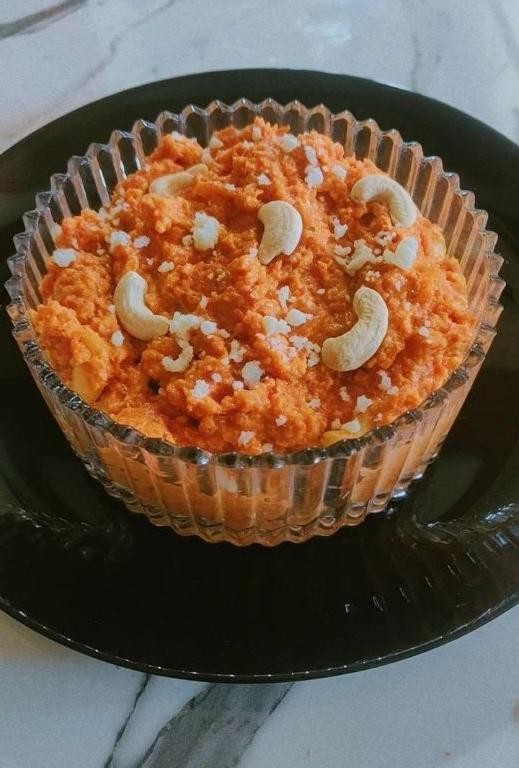
Unveiling the rich tapestry of Indian dessert traditions, Gajar Ka Halwa emerges as a sublime celebration of winter’s bounty, where humble carrots transform through slow, patient cooking into a dessert of remarkable depth and aromatic complexity. This velvety confection balances earthy sweetness with warm spice notes, creating an experience that comforts while it captivates.
Ingredients
- 2 pounds organic carrots, finely grated
- 1 cup full-fat buffalo milk
- ½ cup pure ghee (clarified butter)
- ¾ cup raw cane sugar
- ¼ cup golden raisins
- ¼ cup raw cashew pieces
- ¼ cup blanched almond slivers
- 1 teaspoon freshly ground green cardamom
- ½ teaspoon saffron threads, steeped in 1 tablespoon warm milk
- 1 tablespoon edible rose petals for garnish
Instructions
- Place a heavy-bottomed kadai or Dutch oven over medium heat and add the ghee.
- Add the finely grated carrots and sauté for 12-15 minutes until they release their moisture and the raw aroma dissipates completely.
- Pour in the full-fat buffalo milk and bring the mixture to a gentle simmer, stirring continuously with a wooden spatula.
- Reduce heat to low and cook uncovered for 25-30 minutes, stirring every 4-5 minutes to prevent scorching on the bottom.
- Add the raw cane sugar and continue cooking for another 10-12 minutes until the mixture thickens noticeably and pulls away from the sides of the pan.
- In a separate small skillet, toast the cashew pieces and almond slivers in 1 teaspoon ghee over medium heat for 2-3 minutes until golden brown.
- Fold the toasted nuts and golden raisins into the carrot mixture along with the freshly ground cardamom.
- Drizzle the saffron-infused milk over the halwa and cook for 3-4 additional minutes until the flavors meld completely.
- Transfer to a serving dish and garnish with edible rose petals while still warm.
Aromatic and luxuriously textured, this halwa achieves a perfect balance between the carrots’ natural sweetness and the complex warmth of cardamom and saffron. The slow reduction process creates a dense, fudgy consistency that melts on the tongue, while the toasted nuts provide delightful textural contrast. For an elegant presentation, serve warm in individual clay pots garnished with silver leaf, or chilled as a sophisticated dessert parfait layered with whipped mascarpone.
Badam Halwa
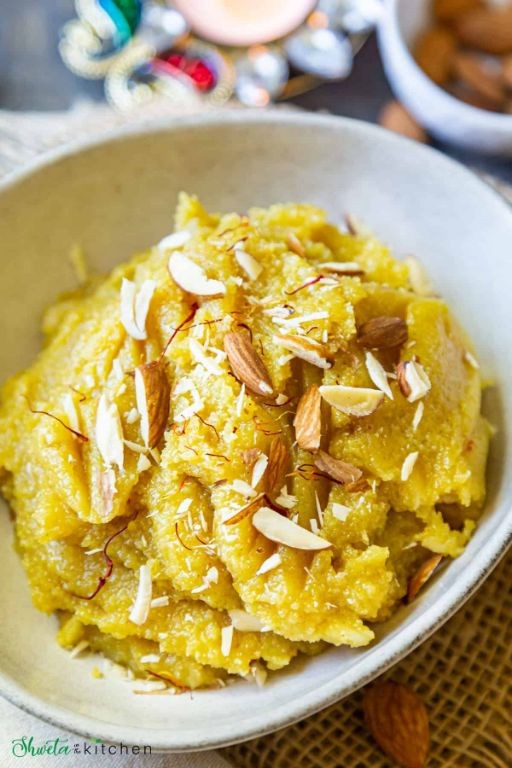
Fragrant with cardamom and gleaming like liquid gold, this traditional Badam Halwa transforms humble almonds into an opulent dessert worthy of celebration. Finely ground almonds meld with rich ghee and aromatic saffron to create a confection that balances delicate texture with profound flavor. Each spoonful offers a glimpse into centuries of culinary tradition, reimagined for the modern kitchen.
Ingredients
- 2 cups raw whole almonds, blanched and peeled
- 1 cup granulated sugar
- ¾ cup clarified butter (ghee)
- ½ cup whole milk
- ¼ teaspoon saffron threads, crushed
- 6 green cardamom pods, seeds removed and finely ground
- 2 tablespoons sliced raw pistachios
- 1 tablespoon edible rose petals
Instructions
- Place blanched almonds in a high-speed blender and pulse until they form a fine, sand-like texture, being careful not to over-process into almond butter.
- Heat a heavy-bottomed saucepan over medium heat and add clarified butter, swirling to coat the entire surface evenly.
- Add the ground almonds to the melted ghee and toast for 8-10 minutes, stirring constantly with a wooden spatula until they release a nutty aroma and turn pale golden.
- Sprinkle granulated sugar over the almond mixture and continue stirring for 3-4 minutes until the sugar begins to dissolve and coat the almonds.
- Pour in whole milk gradually while continuously stirring to prevent lumps from forming.
- Add crushed saffron threads and ground cardamom seeds, incorporating them thoroughly into the mixture.
- Reduce heat to low and cook for 25-30 minutes, stirring frequently, until the halwa thickens significantly and begins to pull away from the sides of the pan.
- Test for doneness by drawing a line through the center of the halwa with your spatula; the path should remain visible for 2-3 seconds before filling in.
- Transfer the halwa immediately to a serving dish, using the back of a spoon to create decorative swirls on the surface.
- Garnish generously with sliced pistachios and edible rose petals while the halwa is still warm so they adhere properly.
Just beyond its jewel-like appearance lies a dessert of remarkable complexity—the halwa offers a velvety texture that melts luxuriously while maintaining subtle graininess from the finely ground almonds. Jewel-toned garnishes of pistachio and rose provide both visual drama and contrasting textures against the rich, saffron-infused base. Consider serving small portions in delicate porcelain cups, accompanied by strong espresso to cut through the sweetness, or as an elegant topping for vanilla bean ice cream.
Conclusion
Vibrant and delicious, these 31 easy Indian desserts bring authentic flavors right to your kitchen. Whether you’re craving creamy kulfi or syrup-soaked gulab jamun, there’s something for every sweet tooth. We’d love to hear which recipes become your favorites—drop a comment below and share your creations on Pinterest to spread the sweetness!
